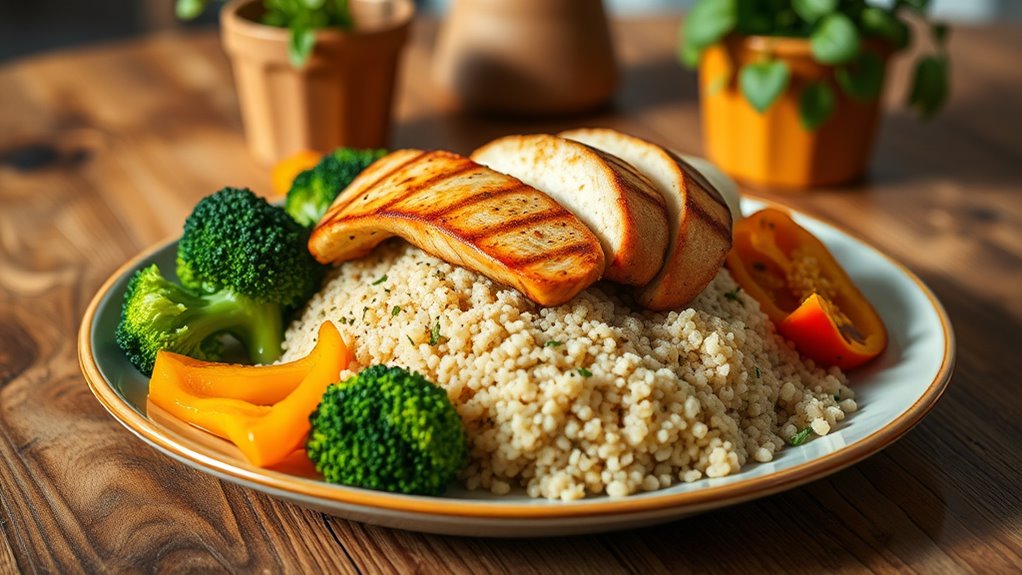How to Balance Your Plate Without Counting Calories
Balancing your plate effectively often feels tedious, especially with constant calorie counting pressure. Yet, you can nourish yourself without the stress of numbers. By focusing on portion sizes and food variety, you can create satisfying meals that promote wellness. Imagine filling your plate with vibrant colors and wholesome options. Ready to discover simple strategies that make every meal enjoyable and fulfilling?
Understanding Food Groups and Their Functions
When you understand food groups and their functions, you can make smarter choices that support your health.
Each group—fruits, vegetables, grains, proteins, and dairy—plays a unique role.
By incorporating a variety of these foods into your balanced meals, you ensure your body gets essential nutrients, boosts energy, and maintains overall well-being. A colorful plate is a practical approach to nutritious eating.
Including science-backed tips for healthier food choices helps sustain your wellness journey.
The Importance of Portion Sizes
Proper portion sizes help you control overall food intake and prevent overeating. Consider these guidelines:
- Use smaller plates to help manage portion sizes.
- Read serving sizes on packaging.
- Measure when necessary.
- Listen to your hunger cues.
Incorporating mindful eating practices can also enhance your awareness of food intake mindfulness, leading to more satisfying meal experiences.
Building a Colorful Plate
To build a colorful plate, start by emphasizing fresh ingredients from different food groups.
Brightly colored fruits and vegetables not only look appealing, but they also provide essential vitamins and minerals vital for your health. Including delicious foods that promote a balanced microbiome can further enhance your gut health.
Emphasizing Fresh Ingredients
How can you create a plate that not only looks vibrant but also maximizes nutrition?
Emphasizing fresh ingredients is key. Incorporate these elements:
-
Seasonal fruits for natural sweetness and antioxidants.
-
Colorful vegetables for essential vitamins and minerals.
-
Fresh herbs to add flavor and health benefits.
-
Whole grains for fiber and sustained energy.
These choices not only enhance your plate’s appeal but also boost its nutritional value.
Diverse Food Groups
A balanced plate features a variety of food groups that not only colors your meal but also enriches your diet.
Aim to fill your plate with lean proteins, whole grains, healthy fats, and plenty of fruits and vegetables.
This combination provides essential nutrients, energy, and satisfaction.
Visual Appeal Matters
Colorful plates aren’t just pretty—they’re also packed with nutrients that benefit your health.
When you build your plate, aim for a rainbow of colors to ensure variety and balance:
- Incorporate leafy greens for vitamins.
- Add vibrant bell peppers for antioxidants.
- Include colorful fruits for fiber.
- Choose whole grains for sustained energy.
Embrace visual appeal, and you’ll enhance both taste and nutrition!
Incorporating Whole Foods
Incorporating whole foods into your diet can significantly enhance your overall health and well-being. Focus on consuming fruits, vegetables, whole grains, nuts, and lean proteins. These nutrient-dense options provide essential vitamins, minerals, and fiber, promoting better digestion and sustained energy levels. Swapping processed foods for whole options isn’t just beneficial—it’s a simple way to nourish your body and support a balanced lifestyle. Additionally, practicing enhanced eating awareness can help you make more informed choices about the foods you consume.
Listening to Your Body’s Hunger Cues
Eating whole foods lays a strong foundation for a healthy diet, but knowing when to eat is just as important as what you eat. Listening to your body’s hunger cues can guide you.
Consider these tips:
- Notice physical sensations of hunger.
- Eat when you’re comfortably hungry, not starving.
- Avoid distractions during meals.
- Reflect on your fullness after eating.
Tuning in to these cues helps maintain balance. Incorporating intentional eating principles can further enhance your awareness and connection to your body’s needs.
Meal Planning for Balance and Variety
While planning your meals, it’s crucial to strike a balance between nutrition and variety to keep your diet enjoyable and wholesome. Incorporate different food groups and flavors to make each meal satisfying. Here’s a simple table to guide your choices:
| Protein | Grains | Vegetables |
|---|---|---|
| Chicken | Quinoa | Spinach |
| Tofu | Brown Rice | Broccoli |
| Salmon | Whole Wheat | Bell Peppers |
To create balanced meals easily, consider these simple tricks for balanced meals that help make healthy eating effortless and enjoyable.




